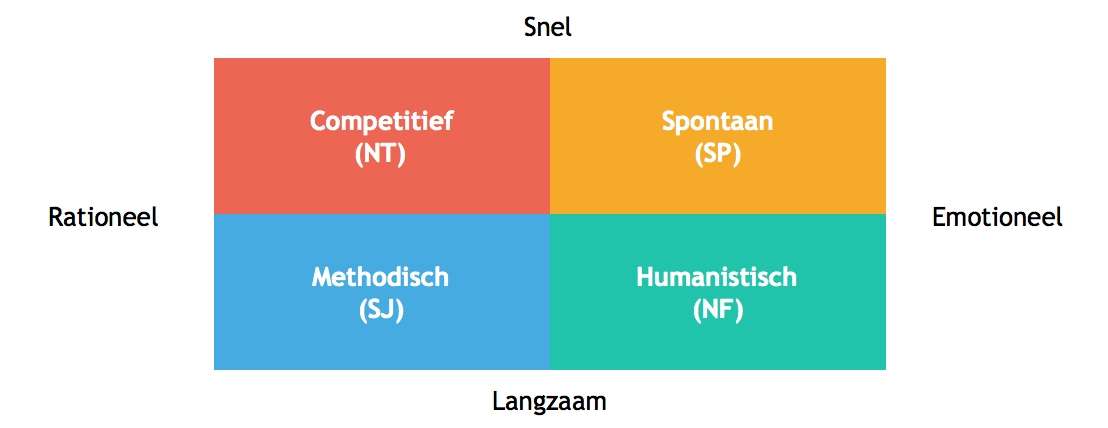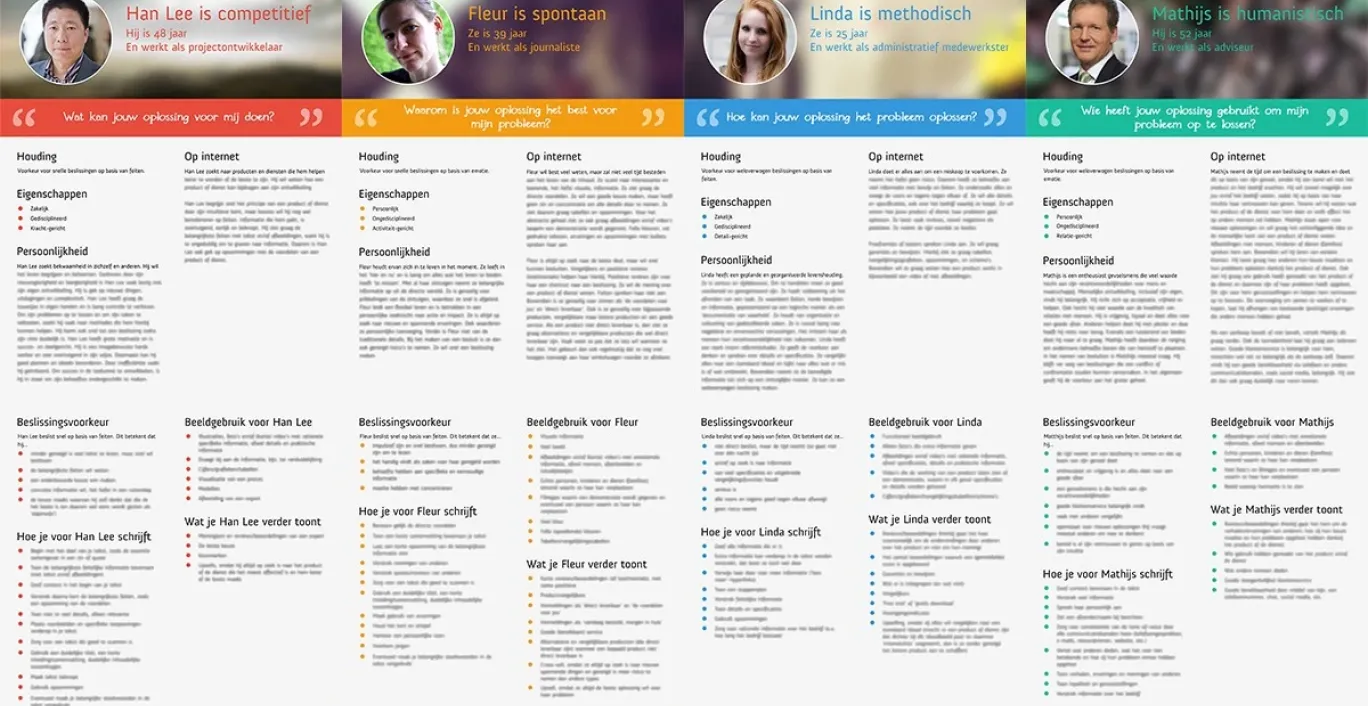How does a visitor decide on your website or webshop? And how can you help them make a decision? Find out with the 4 practical personas based on the MBTI model and start optimising your website or webshop today.
What is MBTI and where does it come from?
MBTI stands for Myers-Briggs Type Indicator. It is a system that lets you understand people's personal preferences. It says something about who you are as a person. For instance, do you like to find out everything yourself or do you prefer to be informed? Do you make your own choice or do you let your choice depend on someone else's advice?
The systematics were developed by Katherine Cook Briggs and her daughter Isabel Briggs Myers, based on Swiss psychologist and psychiatrist Carl Gustav Jung's theory of psychological types.
The theory is not new. For instance, Raymond Klompsma, one of the founders of Concept7, wrote a article about it on Frankwatching, that article was rewritten in spring 2012. Several more articles were published later:
2012: "MBTI Model as the basis for successful conversion optimisation processes" (OrangeValley)
2012: "Website-development-from-personas-to-personality-types" (Frankwatching)
2016: "With Carrie, Samantha, Miranda & Charlotte-to-a-better-website" (Orange Otters)
Misconceptions about MBTI
There are (unfortunately) also misunderstandings about MBTI. I personally think it is important to mention that ...:
MBTI provides an indication of behavioural preference and therefore not knowledge, skills or behaviour itself;
there are no 'good' or 'bad' preferences and therefore no good or bad types;
it is not meant to pigeonhole people, but to gain insight into how people can make decisions could
a person is never 100% a specific type.
MBTI in the basics: The 4 basic preferences and the 16 types
The MBTI type consists of four basic preferences, namely:
Energy: How and from what you get energy
Attention: What you pay attention to when you gather information
Decision: What system you use in your decisions
Life: What kind of life you lead
For each of the four basic preferences there are two choices (also called dichotomies). This leads to a total of eight preferences:
Energie: Extraverted (E) of Introverted (I)
E: Preferably draws energy/inspiration from the world around him.
I: Preferably draws energy/inspiration from the inner world of experience.
Attention: Sensing (S) or iNtuition (N)
S: Prefers to concentrate on factual information acquired through the five senses and through practical applications.
N: Prefers to concentrate on information in the form of broad outlines, patterns, connections and possible meanings.
Decide: Thinking (T) or Feeling (F)
T: Preferably decides based on logic, objective reasoning, ideals and personal reasoning.
F: Preferably decides based on feelings, principles of appreciation and personal and/or others' emotions.
Leven: Judging (J) of Perceiving (P)
J: Prefers a structured and organised attitude to life and is value-judging.
P: Prefers a flexible and spontaneous attitude to life and looks at things as they are without immediately disagreeing with them.
As a person, you make use of all eight preferences, but within each basic preference you have one you prefer. So you have a preference for E or I, S or N, T or F and J or P. By combining the four preferences, you arrive at one of the 16 different MBTI types. For example, if you have the following preferences:
Energy: Extraverted (E);
Attention: Sensing (S);
Determining: Feeling (F);
Living: Judging (J);
then 'ESFJ' is your MBTI type. This MBTI type describes your personality type.
The 16 possible combinations, or 16 MBTI types, are:

Simplifying the model: decision preferences
The original MBTI, by Myers-Briggs, thus has 16 different types. Psychologist David Keirsey based his theory of temperaments on Myers-Briggs' work. Subsequently, brothers Bryan and Jeffrey Eisenberg introduced the 'Buyer Modalities', which is based on Keirsey's temperaments. They classified the 16 types based on decision preferences into two axes. The axes represent the following two questions:
Are you a fast or a slow decision-maker?
Do you decide based on facts or emotion?

This led to the following four types:
The competitive type: iNtuition (N) and Thinking (T)
- decides quickly based on factsThe spontaneous type: Sensing (S) and Perceiving (P)
- Decides quickly based on feelingsThe methodical type: Sensing (S) and Judging (J)
- Decides slowly based on factsThe humanistic type: iNtuition (N) and Feeling (F)
- Decides slowly based on feelings

Just to clarify briefly between the original 16 MBTI types and the 4 MBTI types by the Eisenberg brothers, which is as follows:
16 types: Who you are as a person
4 types: How you prefer to decide
De MBTI-persona’s
The 4 MBTI types have already been described in several articles, including those mentioned earlier. During my graduation in 2012/2013, I tested Bryan and Jeffrey Eisenberg's MBTI theory in reality (N=40) to see if the theory is correct and, more importantly, what the nuances are in this. As a final product, I translated the theory and the learnings into practical 'cheatsheets' in the form of personas*. Each persona represents an MBTI type. In April 2017, I revised the MBTI personas, including with new knowledge I have gained in the meantime. Below is a preview of the revised MBTI personas. You can download a copy via this link: https://goo.gl/forms/jA46W95zTBgixMfJ3 (Google Forms).

* Personas are, in this case, representatives of the various MBTI types. They are archetypal descriptions of fictional people who really seem to exist. Personas are a tool that can be used to make it easier to empathise with the different MBTI types. Use personas to get inspired and evaluate whether a particular web page, text, imagery, etc. is optimally designed.
Also good to know is that ...:
...it is advisable to focus in the build-up first on the competitive and spontaneous visitor, because they decide quickly, and then focus on the humanistic and methodical visitor, because they decide slowly.
...the competitive type suffices with the elements and information listed with this type.
...the spontaneous type also needs the information from the competitive type, only the spontaneous type interprets and uses the elements and information in a different way.
...the methodical and humanistic type also need the information from the competitive and spontaneous types. Again, they interpret and use elements and information differently. They use that, among other things, to determine whether it is worth reading further or delving further into your product or service.
My opinion
There is much fuss and debate about the reliability of MBTI. It would 'never be scientifically proven'. The fact that the theory on MBTI is not scientifically proven, but not disproven either, is not the most important thing in my personal opinion. In my opinion, what matters most is the awareness that not everyone makes a decision in the same way, but does so in different ways. This is also how I use the MBTI framework. The MBTI personas help to see from different perspectives. It is a useful tool to (learn to) put yourself in the shoes of the visitor, or potential customer.
The MBTI personas are also a useful tool when setting up your website or webshop, so that you have a good basis. Of course, this is based on the MBTI theory. So this does not immediately mean that this basis is ideal (or works ideally) for your website or webshop. To find out whether this basis is actually effective for your visitors, you will have to research and/or measure it (e.g. a/b-testing).
So don't stick (too) frenetically to MBTI. Certainly do not segment your target group based on the MBTI model either. There are several questionnaires you can use to find out your MBTI type, but the results are not reliable. This is because the questionnaires have statistical problems. Not only because the conscious brain is used when completing them, but also because there is a high chance that when you complete different questionnaires, you will get different outcomes. A difference in the outcome of one letter can already mean a difference in type of night and day. An ESFJ is a very different type from an ENFJ. There are also numerous factors that affect your type. The three main core factors that determine your MBTI type are:
DNA: What is innate
Upbringing: What you grew up in
Life experience: What you have experienced
And in addition, you have influencing factors such as:
Situation (private vs. business, being under pressure vs. having all the time, because it has to be done vs. because it's nice, etc.)
Buying stage (exploratory, know approximately what he/she is looking for or already know exactly what he/she is looking for)
Attitude
Self-image
Etc.
In short
MBTI is useful for becoming aware that not everyone makes decisions in the same way. It is also useful when building a foundation for your website or webshop, to build on from there and optimise and personalise your website or webshop. So quickly download the MBTI Personas and get started today!
Just for completeness: Should you want to segment your target group, it is advisable to use a different model than MBTI.
Meld je aan voor onze nieuwsbrief en ontvang maandelijks praktische inzichten, tips en tricks om je op weg te helpen naar online groei!
Vul hieronder jouw e-mail in en ontvang direct een handig weetje 🙂
